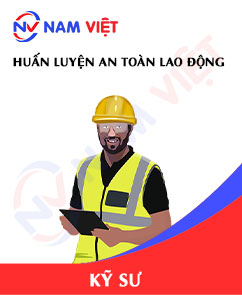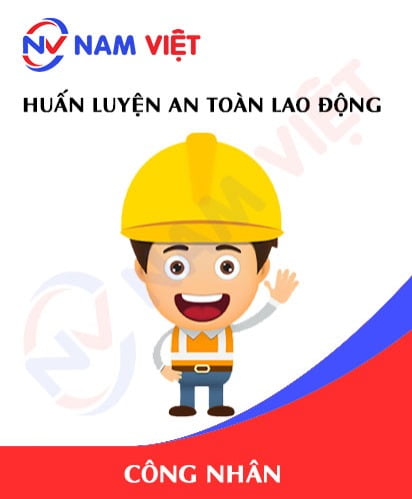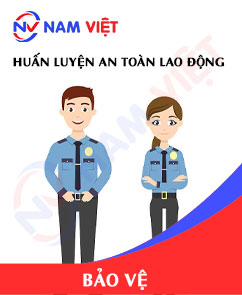Occupational Safety Training for Receptionists
99,000 ₫
Note: The above price is calculated for one person, and the price may fluctuate depending on the number of learners participating in the course and market movements. For more accurate pricing support, please refer to the price list or contact our consulting staff directly.
The Safety Training Course for Receptionists is a course that equips knowledge of group 3 occupational safety. The course will enhance learners’ awareness of how to prevent workplace accidents during the manufacturing process. Accordingly, occupational safety training content is closely aligned with Article 18 Decree 44/2016/ND-CP.
Table of Contents
Toggle1. Overview of Receptionist
a. Important Role of Receptionist
Receptionists play a very important role in the workplace and in service businesses such as hotels, resorts, restaurants, offices, airports, hospitals, and many other places. The role of receptionists is not only limited to welcoming and guiding customers, but also includes many other tasks. Below are some important roles of receptionists:
- Welcoming and guiding customers: Receptionists are the first point of contact with customers when they arrive at a business. They are responsible for greeting customers warmly and friendly, creating a good first impression. They provide necessary information about services, products, or room locations and guide customers throughout their stay or use of services.
- Handling customer requests: Receptionists are the ones who resolve customer requests and needs. They collect information from customers, such as room reservations, schedule changes, special requests, or complaints. Then, they communicate and work with other departments in the business to meet customer requests effectively.
- Ensuring customer comfort and satisfaction: Receptionists must always pay attention to customer comfort and satisfaction. They provide detailed information about services, facilities, and activities in the area to ensure customers have the best experience. If problems arise, they need to resolve them quickly and effectively to ensure customers feel satisfied and return in the future.

b. Receptionist in Different Industries
The role of receptionists is not only limited to service industries such as hotels, resorts, restaurants, and airports, but also appears in many other industries. Below are some examples of the roles of receptionists in different fields:
- Offices: In an office environment, receptionists play the role of welcoming and guiding visitors to the office, collecting contact information and appointments, managing meeting and event schedules, handling phone calls, and answering basic questions from customers and employees.
- Hospitals and healthcare facilities: Receptionists in hospitals and healthcare facilities are responsible for welcoming and guiding patients and their relatives to the correct examination room, assisting with registration and providing necessary information, such as medical records, test requests, and treatment instructions. They may also help manage appointments and communicate with doctors and healthcare staff.
- Shopping centers and retail stores: In retail stores, receptionists help customers learn about products, guide them to necessary areas, process payments, and ensure customer satisfaction. They may also handle returns or exchanges, record customer feedback, and provide information about promotions and special events.
- Travel companies: Receptionists in travel companies welcome and provide information about tours, hotel bookings, and flight tickets, advise on tourist destinations and entertainment activities. They also handle payments, guide customers on travel schedules, and provide support in emergencies or schedule changes.

2. Overview of Occupational Safety Training for Receptionists
a. What is Occupational Safety Training for Receptionists?
- Occupational safety training for receptionists consists of classes that provide awareness on how to prevent workplace accidents for employees. Receptionists belong to group 4.
- The occupational safety training course helps employees recognize and prevent hazards, minimizing risks of workplace accidents during work.
REGISTER FOR OCCUPATIONAL SAFETY TRAINING SERVICE
b. Training Duration
i. Initial group 4 occupational safety training duration
- Total training time is at least 16 hours, including exam time.
- 8 hours of theory on basic knowledge of occupational safety and hygiene
- 6 hours of practical training on direct workplace content
- 2 hours of theory test at the end of the training course
The occupational safety training center will arrange the schedule into multiple sessions depending on the availability of receptionists. Typically, there will be 4 training sessions for group 4, and the course will last for 2 days, provided the manufacturing enterprise arranges continuous study time.
ii. Periodic group 4 occupational safety training duration
- Before the occupational safety training certificate expires, employees who wish to renew must undergo periodic occupational safety training, with the periodic training duration being at least 50% of the initial training duration.
- This means the total periodic group 4 training duration is at least 8 hours, including exam time. After completing the periodic training and passing the test, employees will be reissued and renewed with the group 4 occupational safety training monitoring book.
c. Training Content
| No. | TRAINING CONTENT | TRAINING DURATION (HOURS) | |||
| Total | Including | ||||
| Theory | Practical | Test | |||
| I | Basic knowledge of occupational safety and hygiene | 8 | 8 | 0 | 0 |
| 1 | Basic knowledge of hazardous and harmful factors in the workplace. | 4 | 4 | ||
| 2 | Methods to improve working conditions. | 1 | 1 | ||
| 3 | Safety culture in production and business. | 1 | 1 | ||
| 4 | Rights and obligations of employers and employees; occupational safety and hygiene policies for employees; functions and duties of safety network and hygiene staff. | 1 | 1 | ||
| 5 | Occupational safety and hygiene regulations, signage, safety instructions, use of safety equipment and personal protective equipment; skills in first aid, prevention of occupational diseases. | 1 | 1 | ||
| II | Direct workplace training content | 6 | 0 | 6 | 0 |
| 1 | Identifying hazardous and harmful factors, rules, signage, and instructions at the workplace. | 2 | 2 | ||
| 2 | Practice safe working procedures; incident handling procedures related to assigned duties; evacuation procedures in emergencies. | 2 | 2 | ||
| 3 | Practice simple first aid methods. | 2 | 2 | ||
| III | Final occupational safety training test | 2 | 2 | 0 | 0 |
| Total | 16 | 10 | 6 | ||
See more training content of 6 groups
d. Occupational Safety Training Certificate
- After completing the group 4 occupational safety training course and passing the test, employees will be issued a group 4 occupational safety training monitoring book
- In the monitoring book, information such as full name, year of birth, job, workplace, training time, and results will be clearly shown. It will also contain the red seal and signature of the general director of Công Ty TNHH Huan Luyen An Toan va Quan Trac Moi Truong Nam Viet.

3. Hazards Receptionists Commonly Face
Receptionists may be exposed to some hazards that may affect their health. Below are some examples of common hazards that receptionists may face:
- Security risks and intrusion: Receptionists may face security risks and intrusion from unwanted individuals or groups. This can cause stress, anxiety, and lead to security and safety issues.
- Violence and harassment: Receptionists may encounter situations of violence or harassment from customers or partners. This can cause psychological and physical harm, stress, and affect overall health.
- Toxic substances and chemicals: Depending on the field of work, receptionists may be exposed to toxic substances and chemicals. For example, in hotels, there may be exposure to cleaning agents, detergents, and disinfectants. Improper use or repeated exposure can affect the respiratory system, skin, and eyes.
- Diseases and bacteria: Receptionists have direct contact with many customers and may be exposed to diseases and bacteria. This is especially true in fields such as hospitals and healthcare facilities. Receptionists need knowledge of disease prevention measures and must follow personal hygiene rules to ensure safety for themselves and customers.
- Psychological issues and stress: Receptionists often work in environments with pressure and continuous social interaction requirements. This can cause stress and fatigue for them.
4. Safety measures for Receptionists
To protect the health and safety of Receptionists, the following safety measures can be applied to avoid hazards during work:
- Training and awareness: Provide occupational safety training for Receptionists, helping them to be aware of potential hazards and know how to respond. Ensure that employees understand and comply with safety rules, work procedures, and proper use of personal protective equipment.
- Personal protection: Provide appropriate personal protective equipment such as masks, gloves, safety glasses, and cleanroom garments (in case of working in industries such as healthcare). Ensure employees use and maintain this equipment properly to avoid exposure to harmful substances and bacteria.
- Security and surveillance systems: Provide security measures such as surveillance camera systems, alarm systems, and instructions on emergency response procedures in case of intrusion or security incidents. Ensure employees are trained to respond quickly and correctly in emergency situations.
- Stress management and difficult customer situations: Provide psychological support and stress management measures for Receptionists. Train them in effective communication skills, conflict resolution, and handling demanding customers or stressful situations. Create a comfortable and supportive working environment to minimize pressure and psychological stress.
- Personal hygiene and disease prevention: Ensure that Receptionists comply with personal hygiene rules, including washing hands frequently with soap or sanitizer.
- Periodically organize occupational environment monitoring in factories and enterprises, collect and analyze harmful factors for employees, thereby adjusting and reducing hazards to prevent occupational diseases for them.

5. Salary and benefits of Receptionists
The salary and benefits of Receptionists may vary depending on the field and scale of the business, job position, experience, and workplace location. Below are some general information about salary and benefits of Receptionists:
- Salary: The salary of Receptionists is usually determined by working hours or monthly basis. Salary may vary depending on job position and required skill level. In some cases, Receptionists may receive bonuses or tips from customers.
- Benefits: Benefits for Receptionists also depend on each company’s policies. Some common benefits include health insurance and social insurance, annual leave, public holidays, occupational accident insurance, lunch allowance or dining benefits within the facility, training and career development programs, and maternity leave or family health insurance.
- Promotion opportunities: Some companies offer promotion and career development opportunities for Receptionists. This may include training courses, mentorship programs, or opportunities to move to higher management or specialized positions.
- Working environment: A comfortable and supportive working environment is an important part of benefits. Companies may create a comfortable workplace with facilities such as break rooms, cafeterias, gyms or fitness programs, or recreational activities such as company trips.
6. Benefits of occupational safety training
An Toan Nam Viet provides your business with great benefits after completing occupational safety training courses in accordance with Decree 44/2016/ND – CP on occupational safety and hygiene for companies, factories, and enterprises.
- Employees can identify potential risks of occupational accidents and take preventive measures to avoid accidents.
- Your Business can establish risk prevention measures in the manufacturing, operation, and maintenance process.
- Minimize costs when safety risks occur at work.
- Uninterrupted production processes help increase labor productivity and product quality.
- Comply with occupational safety laws and avoid legal risks.
- Create reputation and professionalism in all aspects, thereby enhancing your business brand.
Training courses of Nam Viet are solutions to prevent and resist external factors affecting individuals so they can avoid dangers that may lead to injuries or even fatalities.
REGISTER FOR OCCUPATIONAL SAFETY TRAINING SERVICE
7. Customer feedback after completing the training course
An Toan Nam Viet has many years of experience in the mission of accompanying many businesses in Vietnam in general and in the southern provinces in particular. That responsibility for Nam Viet is extremely precious, which is why Nam Viet’s Occupational Safety Training is always increasingly professional. The driving force for An Toan Nam Viet to grow strongly until now comes from both positive feedback and suggestions from businesses. Below are the feedbacks from our partners we have served.
Bac Nam E&C Construction Investment Joint Stock Company
“The first time using services at An Toan Nam Viet I was very surprised by the enthusiastic 24/7 support of the consulting team. The class organization was very quick and convenient for our company, thank you very much for Nam Viet’s service!”
Hoa Dat Construction and Trading Joint Stock Company
“Nam Viet’s service has helped us a lot in simplifying occupational safety and completing safety documents for the working process. The consulting team is enthusiastic and timely in answering our questions. 5 stars for Nam Viet.”
See more customer interviews after using the service of An Toan Nam Viet
8. Occupational Safety Training Capacity of An Toan Nam Viet
An Toan Nam Viet is a reputable and quality occupational safety training center in Vietnam today. With occupational safety training sessions held continuously at manufacturing workshops, factories, or construction sites nationwide (63 provinces in Vietnam).
REGISTER FOR OCCUPATIONAL SAFETY TRAINING SERVICE
Occupational safety training license
- An Toan Nam Viet has been inspected and granted a certificate of eligibility for occupational safety and hygiene training by the Department of Safety under the Ministry of Labor – Invalids and Social Affairs. This further strengthens our occupational safety training capacity.

Documents and lectures
- Before occupational safety training materials are included in the OSHE training courses, they are reviewed and approved to ensure that lectures are always accurate in knowledge and effective in practice.
- The teaching methods of the instructors are standardized according to the teaching standards of An Toan Nam Viet, which have been researched and summarized by experts in occupational safety and hygiene training to bring the highest knowledge acquisition efficiency to learners.
Facilities
- Controlling classroom factors that affect training will increase teaching efficiency and learners’ knowledge acquisition.
- Training support facilities of our center always arrange spacious classrooms that meet standards of area, lighting, training equipment, etc.
9. Nationwide reputable and quality occupational safety training center
At An Toan Nam Viet, we always put occupational safety training dedication as a top priority. For us, imparting knowledge of self-protection for Receptionists so that they can have safety in their livelihood journey is contributing to building the country.
To ensure effective training, we carefully and meticulously prepare every small detail. From preparing tools, teaching equipment to curriculum, documents, sound, and lighting.
Our occupational safety trainers are experts with many years of experience in the field. They even have research projects on identifying hazards in all industries and how to prevent them.
Lectures from trainers are summarized from practice and conveyed vividly and easily understood by employees. These factors help employees feel comfortable during study time and absorb our teaching well. Of course, the conveyed knowledge always adheres to Decree 44/2016/ND-CP.
From there, they gain many preventive measures against dangers and ways to protect themselves. At the same time, they can apply them most appropriately in actual work.
Our safety training center is proud to provide reputable and professional occupational safety training services with the following advantages:
- Competitive training costs but training quality is still ensured.
- Flexible training schedules to fit with company production.
- Quick occupational safety training certification procedures, in accordance with the law.
- Trainers are highly experienced professionals.
- Classrooms are controlled for factors affecting training, increasing teaching efficiency and knowledge absorption of learners.
- Lectures are compiled in accordance with occupational safety work at enterprises.
- An Toan Nam Viet works dedicatedly and professionally to support customers accurately and quickly.

10. Refer to more occupational safety training documents
1 review for Occupational Safety Training for Receptionists
No comments yet















caotiensyhung.07081999
Dịch vụ tốt